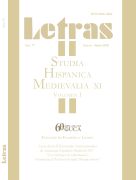Perspectivism and proverbial discourse in the portraits of La Celestina
Keywords:
La Celestina, Perspectivism, Proverbial Discourse, PortraitAbstract
The complex technique of the portrait used by Fernando de Rojas in La Celestina has been the object of several studies and yet it is always suggestive for new critical approaches. As Snow observes (1992), the characterization procedure of Rojas “es un arte que deja que las palabras nos entreguen las imágenes que de unos personajes tienen los otros personajes. Puestas en íntima proximidad, estallan como tienen que estallar y ayudan a retratar a las personas y personalidades detrás de las palabras”. In fact, the characterization is delineated as the dialogues progress and is constructed from multiple points of view, complementary or divergent, and the reader is responsible for the assembly of the representation of the characters drawn by that game of different figures. In this article I propose to approach the perspectivism that is reflected through the perception of the protagonists by themselves and other characters, and put it in relation to the application of the proverbial discourse to the characterization and justification of the representations of characters.Downloads
References
BARANDA, Consolación, 2004, La Celestina y el mundo como conflicto, Salamanca, Ediciones Universidad de Salamanca.
BIZZARRI, Hugo, 2004, El refranero castellano en la Edad Media, Madrid, Ediciones delLaberinto.
DEYERMOND, Alan, 2008, “‘El que quiere comer ave’: Melibea como artículo de consumo”, Medievalia 40, 45-52.
FARAL, Edmond, 1923, Les arts poétiques du XIIe et du XIIIe siècle, París, Librairie Ancienne Éduard Champion.
LACARRA, María Eugenia, 1989, “La parodia de la ficción sentimental en la Celestina”, Celestinesca 13-1, 11-30.
LIDA, María Rosa, 1962, La originalidad artística de La Celestina, Buenos Aires, EUDEBA.
PUERTO, Laura, 2008, “La Celestina, ¿una obra para la posmodernidad? Parodia religiosa, humor, ‘nihilismo’”, Celestinesca 32, 245-263.
ROJAS, Fernando de, 1994, La Celestina, ed. Dorothy S. Severin, Madrid, Cátedra.
—————, 2008, La Celestina. Comedia o Tragicomedia de Calisto y Melibea, ed. Peter Russell, Madrid, Clásicos Castalia.
SNOW, Joseph T., 1989, “La caracterización de Calisto y Melibea”, en A. Montero, C. Morón y J. C. de Torres (eds.), Imago Hispaniae. Homenaje a Manuel Criado de Val, Reichenberger, Kassel, pp. 459-472.
—————, 1992, “Una lectura de Celestina-personaje y de la obra de Fernando de Rojas”, en R. Beltrán, J. L. Canet y J. L. Sirera (eds.), Historias y Ficciones: Coloquio sobre la literatura del siglo XV, Valencia, Departamento de Filología Española de la Universidad de Valencia, pp. 279-287.
TORREGROSA DÍAZ, José Antonio, 2013, “Cuando andan a pares los diez mandamientos (Celestina, IX)”, Celestinesca 37, 139-148.
Downloads
Published
How to Cite
Issue
Section
License












